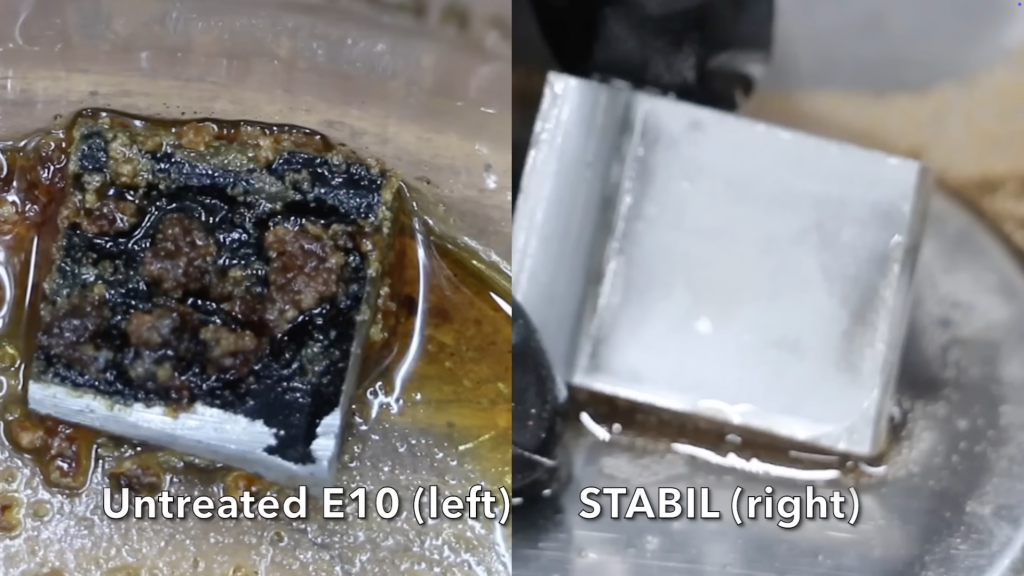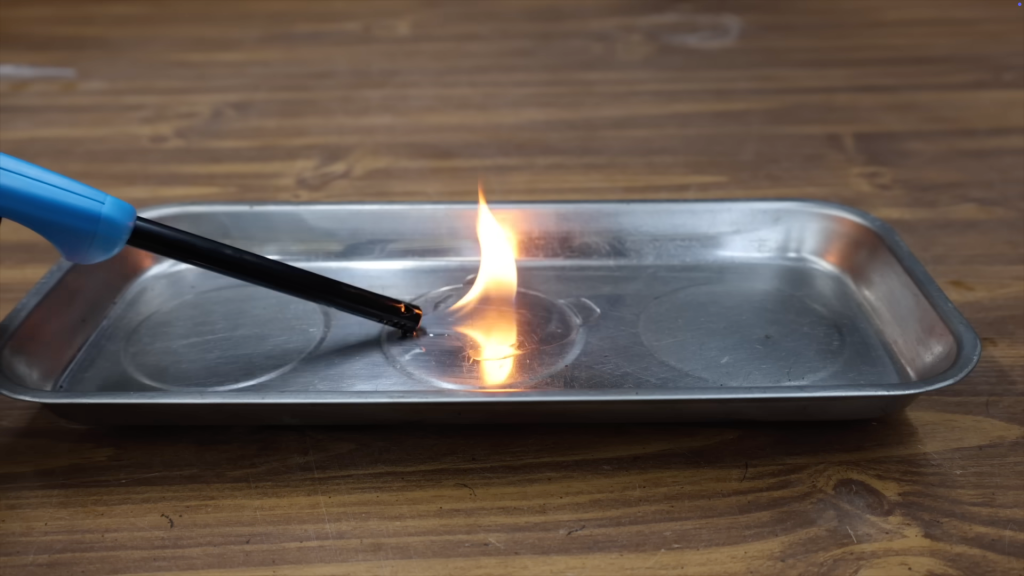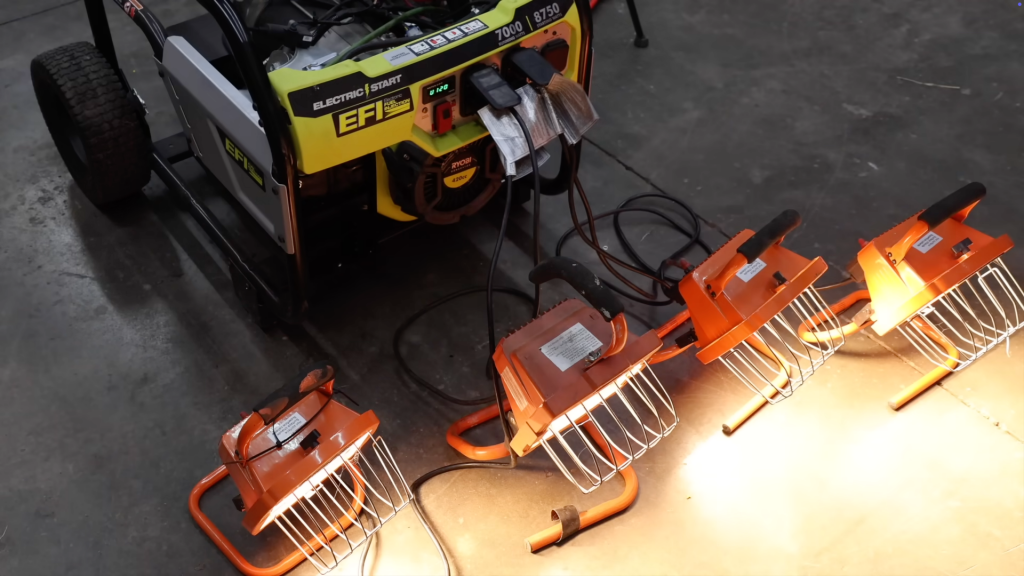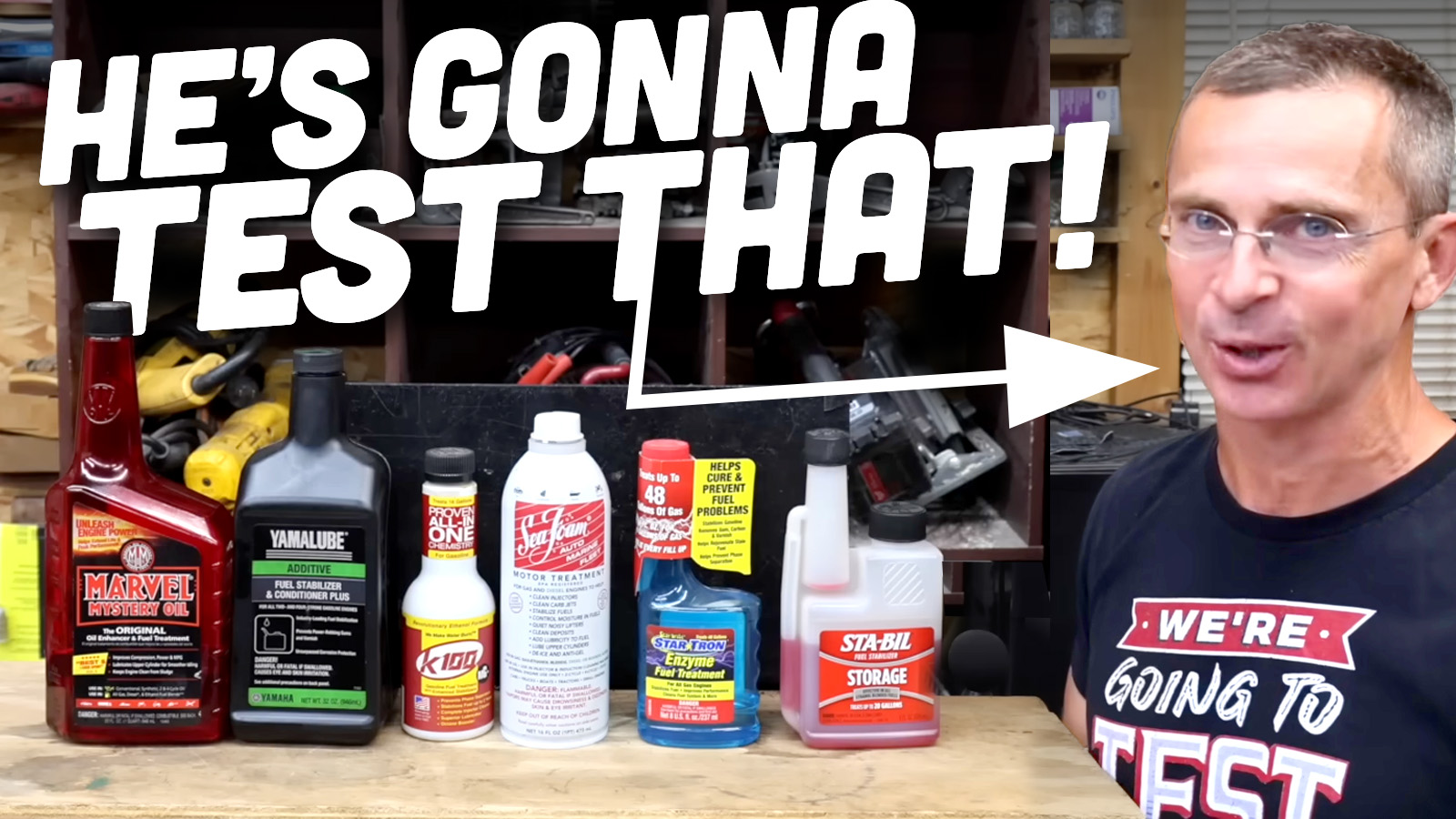If you’ve ever walked the cherished halls of your local auto parts store, you’ve probably come across an aisle stuffed to the brim with different juices, elixirs, sprays, and additives. Many of those bottles and cans are pretty useful (I swear by Liquid Wrench), while others offer pie-in-the-sky cures for stuff like leaking radiators (if you can’t seal it from the outside, just give up and replace it).
Fuel stabilizers usually occupy a shelf in that aisle. As the name suggests, these liquids, when added to a tank of gasoline, promise to “stabilize” the fuel’s chemical properties so it lasts longer (gasoline lasts up to six months before degrading, according to Exxon Mobil). Some fuel stabilizers promise to stretch that period to up to two years.
These stabilizers don’t just promise to keep fuel healthy. They also promise to keep old fuel from destroying your car. Road & Track has a neat little explainer on how that happens:
What is this magic tonic stabilizing? It’s trying to prevent oxidation. Gasoline can form gummy deposits and layers of varnish that gunk up any part of the fuel system they can reach. Most gas contains some amount of ethanol, and that spells more trouble; ethanol is hygroscopic, meaning it attracts water from the atmosphere. Water and ethanol are corrosive, which is bad news for older tanks, fuel lines, and carburetors. Ethanol can also do nasty things to rubber seals.
What Exactly Is Fuel Stabilizer?
According to Berryman, a manufacturer of fuel additives and treatments, stabilizers work by employing a mixture of antioxidants and lubricants that, on a chemical level, repel water and limit evaporation. Basically, it’s trying to stop water from building up in your gas and wrecking your car’s fuel system from the inside. But does it actually work? One man decided to spend five years running a series of experiments to find out.
Todd Osgood of the Project Farm YouTube channel has been performing at-home comparison experiments on a litany of different products for years, from tire pressure gauges to ratcheting wrenches to anti-freezing diesel additives. In a world where it feels like companies are increasingly trying to deliver less performance for more money, Osgood’s independent backyard shed tests are a refreshing sight, even if not all of them are that scientifically precise (though he does a pretty good job in general).
Though Osgood doesn’t wear a lab coat, he likes to be incredibly thorough with his tests. For this experiment, he wanted to compare four of the most popular products often used as stabilizers: STA-BIL, Yamalube, Star Tron, and K100.
“This review has taken a total of about five years to complete, a very long review,” Osgood says to start off. “However, I think it’ll be worth your time. The first three years of the review, I tested some fuel, and after the first three years, I decided to create a new batch of fuel, and that took an additional two years.”
The Corrosion Test Has One Big Standout
He threw in Marvel Mystery Oil and SeaFoam into the mix for their similar treatment properties, and also some two-stroke oil, just to see what would happen. His first test involved jarring up six pieces of pot metal (cheap metal made of stuff like aluminum, lead, and zinc) and mixing them with some fuel mixed with 10% ethanol, the additive, and a tiny bit of water.

Osgood then left the jars alone for three whole years to see if any of the stabilizers would prevent corrosion. Amazingly, out of the six treatments tested, he found that only one, STA-BIL, was able to keep the metal fully clean. Every other product let corrosion build up on the metal to some degree (though K100 came in a close second, with just a few bits of corrosion on the metal).
The Rubber Hardening Test Was A Bit Less Conclusive

For the next test, Osgood jarred six pieces of rubber hose paired with some fuel and each additive to see how well the products could help with hardening of the rubber (the goal here is to keep the rubber as soft as possible, so it doesn’t harden and crack, causing a leak). To test the rubber’s hardness, he used a handheld durometer, which uses a spring-loaded pin to measure how much force is necessary to penetrate a surface. No matter the brand, there wasn’t much of an impact on hardness, but interestingly, it was the STA-BIL that showed a slight edge here, too.
Like A Hydrocarbon To A Flame

After that, Osgood tried to see which of the stabilized fuel mixtures would ignite using a simple lighter after sitting for 20 months. Amazingly, the STA-BIL was, again, the only product to show signs of life here. It was the sole mixture to actually ignite when presented with a flame (even if it was just for a second). None of the other mixtures could muster that performance.
The Experiment You Should Actually Care About

For the final and most important test, Osgood wanted to see how the old fuel and stabilizer would run when put through a generator. The fuel mixed with the SeaFoam, the Marvel Mystery Oil, the K100, and the Yamalube all needed starting fluid for the engine to fire up, while the Star Tron and the STA-BIL didn’t need assistance. Of the six, Osgood praised the Star Tron and the STA-BIL for keeping their respective spark plugs clean (he swapped out the generator’s spark plug for each test run to ensure the competitors would have equal chances of running).
Like I mentioned before, these sorts of tests aren’t perfectly scientifically precise, being done with mason jars in a barn by a (smart) YouTuber and all. So it’s best to keep that in mind. All that being said, it seems like there are a few brands that are better than others, and one clear winner. We don’t want to spoil Osgood’s five years of hard work, so we’ll leave it to you to watch the full video to find out where each brand ended up.
Top graphic image: Project Farm/YouTube









“these sorts of tests aren’t perfectly scientifically precise, being done with mason jars in a barn”
Lab conditions are more scientific, but which method is more real-world? “In the barn” testing is as real world as it gets
Project Farm is one of my go-to channels for product reviews. Not because they are scientifically precise and extract every ounce of data possible. But because they are practical, unbiased and thorough. I don’t always need the absolute best product money can buy. I can get a ‘good-enough’ version of a tool or product based on a lot of his testing.
When I was a kid I stared mowing my parents’ lawn as soon as I was big enough to push the mower. I quickly learned the yearly ritual where the lawn mower would sit idle over the winter and in the spring I usually had to haul it to the local small engine repair shop and get it revived. Sometime in my early 20’s I learned about fuel stabilizer and that was a game changer. Now I use Sta Bil in all my small engine gasoline. I know not to leave fuel in things like generators or pressure washers that only see occasional use. My lawnmower always gas treated has in it, and starts up easily every spring and has never missed a beat in about 25 years now.
Project Farm is one of the best YouTube channels out there. If you’re thinking about buying something (tools, knives, water bottles, cleaning products), just Google “project farm [item you’re looking for]” and there’s probably a video.
I highly encourage those looking to debunk the “more money spent on an item is always better” myth, and spend less of their money for better products, check the channel out.
With he’d included ethanol free fuel in the test. Every other comparison I’ve seen says straight gas is better than E10 with any brand of stabilizer.
Where does one acquire such mystical nectar these days?
Our local gas station has it. 90 octane recreational fuel.
Amazing, I’ve only ever seen it at stations that sell “Race Gas” and those are pretty thin on the ground ’round here.
A few stations around me even have E0 regular, so you don’t have to pay the premium upcharge too. That’s fairly uncommon though.
https://www.pure-gas.org/
Thanks for that, closest one is about 10 minutes away. Most of them in my state are out in the sticks, or at marinas, which makes sense.
Canada recently changed fuel regulations such that basically every gasoline or diesel supply must have ≥5% “something else” added, with escalating rates of dilution from here to 2030 and beyond. It used to be that one could rely on Shell/Esso/Costco to have ethanol-free gas at 91 octane but now every pump is labelled “May contain up to 10% ethanol.”
I love this guy’s channel. He’s always about testing things in the real world, and his video on RESTORE that increases compression in a can was pretty eye opening. I’ve used it successfully on lots of projects ever since I saw that one!
Not to sound like an advertisement but Sta-Bil is what I put in my mower and motorcycle each fall, I fill up the gas tanks, add Sta-Bil, and run them a few minutes and then park them for the winter (well I do ride the motorcycle once or twice on warm winter days.) They, especially the mower which has sat for months, always starts the first try in the spring. I put both on a trickle charger too, a solar trickle charger on the mower in my shed and an AC trickle charger on the motorcycle.
I never buy any tool or product without checking for a Project Farm test first.
That first pic of the untreated metal is horrifying; it reminds me that I’ve left my Firebird sitting for far too long with untreated fuel.
I adore Todd’s videos. They are invaluable for cutting through the crap, and illustrating which products aren’t totally full of shit. However I have noticed something odd. Each year his presentation style grows more… enthusiastic and high pitched. It’s gotten to the point where I’ll watch his videos muted.
We’re gonna test that.
Very impressive.
Agreed. I can’t listen to him for too long, because he sounds like he’s been snorting coke and huffing helium, then gaming my YouTube settings to 150% speed. I typically just fast forward to the end.
It helps to slow him down to 75% speed.
I’ve always used Sta-bil in my chainsaw and generator and whatnot just because that’s what was on the shelf in my local hardware store years ago. The saw is old, so it’s hard to start regardless, but it still works.
I watch these Youtube comparison videos of various kinds… sometimes they’re just ranking things based on the presenter’s preference (Indomie Mi Goreng instant noodles for the win apparently) while other times, there’s some attempt at gathering empirical data as in this case. I generally prefer the latter type of course.
BTW, I bought a few boxes of different sizes of Amazon ‘basics’ branded batteries a couple years ago, and they’re all crap. They die as quickly as any generic/off-brand battery… I don’t know what company makes them for Amazon, but it sure isn’t Duracell or someone reputable.
No his stuff is not scientifically precise and it’s better that it’s not. My gas cans on the shelf in the garage don’t exist in a scientifically precise world, so I want to know which treatment is best for the real world.
Sta-bil it is! It was the one I bought most often anyway.
that’s exactly what I was thinking as well. no, these weren’t done in precisely controlled labs, but everyone using these would be using them in conditions much closer to what he tested them in.
The ethanol-blended fuel changeover has never failed to cause headaches on two fronts — first, people caught unawares by the first winter off-season of letting equipment sit and then discovering that the ethanol and water absorption has royally mucked everything up. But then there’s the secondary failure mode as ethanol attacks the rubber lines and gaskets in older engines, which not only causes leaks, but generally causes fuel system clogs thanks to all the tiny bits of rubber breaking loose and stuffing up carburetor jets. Usually only after you’ve struggled to get the carb cleaned out after the first Spring with stale fuel. Pure, ethanol-fueled misery.
After dealing with it all here in the states, we got to watch from the sidelines as ethanol blends were introduced over in Europe, to predicable misery.
To anyone anywhere in the world where ethanol blends still haven’t reached, be prepared. Lear to use fuel stabilizer and get ready to replace all rubber components in the fuel systems of older equipment with modern ethanol-tolerant ones. You’ll save yourself a ton of headaches.
Personally, I’ve found that particularly with ethanol-blended fuel, just treat it with Sta-Bil when you bring it home. All the time, all year long. Especially here in the US Midwest were there’s a huge incentive to maximize ethanol usage. Unless you’re feeding a landscaping business which burns through fuel like crazy, it will accumulate moisture and go bad in no time at all. I’ve been able to find ethanol-free fuel and use it exclusively in my small equipment — especially for my opposed-twin Onan-powered garden tractor from the 90s — that engine is a bit picky about having good fuel. And I throw Sta-Bil in it anyway, because even the ethanol-free fuel is a bit suspect for storage life.
A note to anybody with 2-cycle chainsaws, weedwhackers, and other equipment that needs pre-mixed fuel — 2-cycle oil already has adequate stabilizing properties and leaves a good protective film in the carb and fuel system. But for anything with oil injection, don’t forget to keep stabilizer in its fuel, and run the carb dry at the end of the season; it’s no different than 4-cycle power for risk of carb clogs from ethanol/water crud buildup.
Not just for storage but I’ve noticed that my 2-stroke snowmobile runs poorly on E10, but on my 4-stroke it seemed to make no difference. So I started seeking out places where the premium is ethanol-free for the 2-stroke. One tank of E10 gas in the 2-stroke isn’t really noticeable but if I fill a second time with E10 it gets crap mileage and doesn’t have it’s normal snap. The 4-stroke I can run 87 octane or 91 E-free and it runs exactly the same.
I buy ethanol free for my small engines, but I treat with Sta-Bil as well. At my gas station it is the same pump handle for all the different flavors, so who knows how much ethanol you are getting that was left over in the hose even when you buy ethanol free.
For years every spring I’d have to open my lawnmower carburettor and clean it all out before the thing would start. About 5 years ago I started using fuel stabilizer, and I dump a little extra in before winter. Starts 2nd or third pull every spring now. Pretty sure it’s the ethanol causing jelling. I used to be able find ethanol free, but that became a lot of effort.
It was a good video. I generally use Stabil, but am currently working through a bottle of the Canadian Tire Motomaster equivalent. It works fine.
I tend to use a smaller can for my mower gas too. Hard for it to go bad if you run out quickly.
I find Todd’s videos very useful, but his tendency to start every sentence with “and” makes me jumpy. That said, he often does what I do when shopping, which is consider what is the best product, and which one offers the most value for money.
I think that’s kind of an artifact from the way he edits the tests.